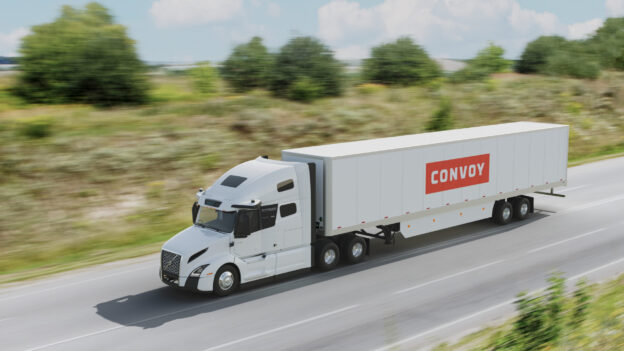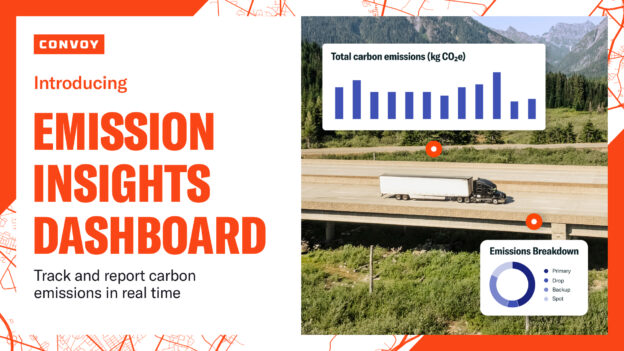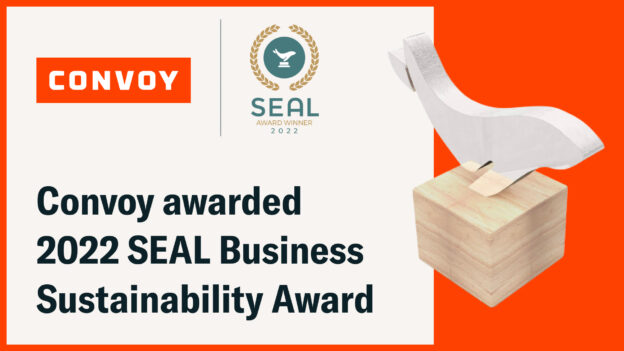The Biggest Challenges in Sustainability
Sustainability • Published on August 9, 2021
Sustainability is an exciting initiative for many organizations who want to do good for people, planet, and profit, but it is not without its own set of challenges. From the overarching feeling of overwhelm regarding where you begin, to dealing with changing old school corporate mindsets, finding funding, aligning the supply chain, and figuring out a way to measure your impact, the sustainability facet of running a business can be quite challenging indeed.
Convoy’s Business of Sustainability interview series addressed some of the biggest challenges faced by companies large and small around the globe. Here’s what my guests had to say on the topic.
- Getting Started. David Young, Chief Operating Officer at Seattle Seahawks: “Starting. Getting off the ground. Once you build that momentum, it starts to build on itself and you just see the benefits to it. So, getting the initial program off the ground is probably the most challenging part. And when you’re building a program, anything new is always going to be facing challenges. Anything new that could look like it’s going to add incremental cost is going to present a lot of challenges. And as we pivoted from the waste diversion into utilities, that was another challenge for us because there is upfront cost in some of the retrofits, some of the additional installs that we had to do at the stadium to install low-flow water valves for example. We put a solar array on top of our events center, which, at the time, was the largest in the state of Washington. It generates over 830 thousand kilowatt hours of electricity and provides about 23-24% of our overall electricity needs at the stadium. So, once we got over those hurdles of the initial capital outlay, we started realizing benefits and savings afterward. If I could offer advice to anyone starting a large-scale program like this is look at the long term returns and benefits you’re going to have. Not just in the case of financial benefit — which we reduced our overall cost on utilities by about 21% with many of the measures we put into place since 2010 — but also the benefits.”
- Getting Focused. Jess Bensley, Senior Product Line Manager at Teva, Deckers Brands: “We started off just swimming in a lot of different directions and I’m sure that’s where sustainability comes into a lot of work. We cared a lot and so we wanted to do a lot, but we had to focus. Packaging felt like a natural one and then looking at products is a natural way to get started as well. But as we were trying to tackle all these things — and they’re really hard to focus on — as we talked about it, we landed on three pillars that we really focus on: 1) product; 2) circularity; and 3) climate.”
- Weaving Sustainability Into The DNA Of Your Business. John Sadlier, Chief Sustainability Officer at Ardagh Group: “Weaving sustainability into the DNA of our business — sixteen thousand employees across Europe, North America, and South America — that’s the biggest challenge. How do we do that? How do we get every employee in Ardagh Group engaged in this agenda? Community involvement, factory involvement — there are a whole bunch of levers to be pulled there, but that’s a huge journey to try and reach all of the employees, get all of them excited, and really get this agenda where we need it to be.”
- Learning To Look Through A Different Lens. Josh Raglin, Chief Sustainability Officer at Norfolk Southern Corporation: “When we first thought about sustainability, it was more about environmental compliance. It was a little bit about fuel efficiency, and it was more about economic returns. Now it’s more about engagement with communities. It’s about using a different set of lenses when you look at projects, instead of just pure financial return. It’s really how you can create multiple values and create things in a different way.”
- Having A Positive Mindset To Address Obstacles And Challenges. Mokhtar Alkhanshali, CEO and Founder of Port of Mokha: “We live in a world with a lot of problems and if we try to think about what is something I can solve, it gives you a lot of motivation to get through those hurdles — both internal and external problems. I saw this opportunity and I was a young person when you’re trying to find your path in life. I was trying to figure out how to do this and I found out business was a way to do this. Creating a company that could do this and my biggest issue first was actually not external. It was actually internally I did not have any business knowledge. I did not know anything about supply chain management, marketing, etc. I didn’t know anything about quality control. But that’s also the most exciting part of the business. You just jump into a new world. You get to read the books. You get to go to conferences. You get to, you know, meet people, and so I’m very fortunate to have been around some incredible teachers in business.”
- Recognizing You Can’t Solve Every Issue Alone. Julie Mishner, Product Manager at Jabil Packaging Solutions: “The increase in customer demand for sustainability is having revenue impact. Nobody can solve this problem alone, so we’re partnering with our customers and our suppliers. The relationships we are developing across the supply chain are huge and feel like nothing we’ve done before. We are currently developing new material compounds which are home compostable for our customers. This is not something I thought I would have seen us do five years ago. ”
- Wanting To Always Achieve More. Kimberley Sundy, Director, Corporate Sustainability at Kellogg Company: “Not only do we always feel like we could be doing more, but we also set really high standards for ourselves. In 2019 at the Sustainable Brands Conference, our CEO unveiled our next generation of commitments. One of the things that we all like to say at Kellogg is, “Even better if…” and I think that has been one of the most inspirational environments for me to work in because people at Kellogg love to give their best, but they also love to think about what even better would look like. Every year we publish our corporate social responsibility report in the spirit of transparency and collaborate with the World Business Council for Sustainable Development to make sure our report showcases the best of our goals and our ambitions as well as our progress against our goals.”
- Collecting And Analyzing Data To Demonstrate Results And Understand Impact. Rob Johnson, VP of Sustainability and Transportation for Seattle Kraken and Climate Pledge Arena: “Finding and collecting all of the data from all these different sources, analyzing that data, and then accounting for the carbon footprint of the building is going to be an enormous challenge. We’ve got very little scope one emissions. But when we think about all of the other things that happen within a building as busy as ours with 200 programmed events every year so that’s an event 2 out of every 3 nights, this is an enormous task. We have 10,000 to 20,0000 people coming to and from that event, purchasing food, using the restrooms, the clean up of all of those people before and after the events, the total amount of operations of this facility, etc., collecting and analyzing all of that data, and then finding ways to understand the impact of that is going to be an enormous challenge.”
- Working With Companies At All Stages Of Sustainability Initiatives Within Your Supply Chain. Zach Freeze, the Senior Director, Strategic Initiatives, Sustainability at Walmart: “Companies are at all stages — some are just getting started while others have long established and assigned targets they’re actively pursuing. Walmart has suppliers at every step along this journey, and we want to engage with them wherever they are in order to move them up the curve. We want to make it really simple to get started and then push suppliers who are doing great work to move even faster and farther. Project Gigaton is designed for us to activate with any supplier at any level to begin and understand the business case and keep it front and center as to why it matters to Walmart. We are typically one of the larger customers for these suppliers, so we want to make sure they understand it is very important for us and for us to help them as well. We want to provide resources and collect everything we can and we learn from our environmental NGO partners like World Wildlife Fund or Environmental Defense Fund and, in turn, translate these learnings into actions on things like reducing food waste, reducing packaging, reducing energy use and making that conversion to greenhouse gas and making it really simple to use, easy to engage with, and incentivizing and encouraging companies to do more.”
- Identifying The Next Step In Your Sustainability Journey. Bryan Pape, CEO of Miir: “It was easy for us because we started with the concept of sustainability from day one. So, it’s easier for us to bake it into the model and it becomes second nature. For a company who doesn’t grant money or give in a way that we do, it’s hard to go from not doing anything to doing it. My encouragement for anybody who is not doing it or doing it lightly is just take that next step. What is that next step for you as a business to either look at grant making or setting aside a little bit of money for your employees to help out with? Even in sustainability, it’s the same thing. Just take the best next step. Whether that’s reducing plastic in your packaging or offsetting one of the three scopes within becoming climate neutral or researching being a certified B corp. There are always a couple of steps and it can be very daunting at first thinking you have to do all of this work, but it just takes one better step day after day to achieve the sustainability goals you have.”
- Securing Finance For Your Initiatives. Kelly Fisher, SVP/Head of Corporate Sustainability at HSBC: “A lot of things can’t happen unless there is financing for it. For example, if you’re a major shoe company and you know you can change the way you manufacture one of your shoes and make it from recycled materials, that’s great. The impulse to want to do that is the right thing, but if you don’t have the funding in the company right now to do that, a loan from a bank who believes it needs to happen, can make it happen. One of the most exciting examples of what we’ve done to date is with Wal-Mart. They have one of the world’s largest supply chains and have an enduring commitment to environmental sustainability. What we’re doing now with them is simply tiering the way their suppliers are paid depending upon an impartial rating of how sustainable they are.”
- Deciding Who Will Oversee Sustainability. Wylie Robinson, Founder and CEO at Rumpl: “We don’t have a sustainability team at Rumpl. It’s just a small team where everybody is responsible for knowing what they are doing and the effects they have.”
- Setting Priorities. Jane Franch, Director, Strategic Sourcing & Sustainability at Numi Organic Tea: “There is so much to be done, it is such a challenge to sift through all the priorities and say “Where do we put our attention now?” It has been a journey about listening to our partners and when we enter a tea sourcing relationship, we try to listen deeply and understand what is happening at this origin and what the challenges are. If we enter into a business relationship, what are the different things we each bring to the table? How can we leverage our position and be the voice of our consumers to have an ethically sourced, cleanly produced product? How can we bring that back to the place of origin to positively affect the lives of the people there? And often that is achieved by listening to what is actually needed in the situation and determining if it is the right kind of match. We employ deep listening to think through what the priorities are.”
- Maintaining A Sustainability Culture. Jeff Smith, Vice President of Sustainability at Six Senses: “The biggest challenge over the last few years within our organization has been our growth. The challenge is to maintain the culture of understanding that sustainability is core to what we do. Every time we open a new hotel, we have all of the orientation training, learning our brand for the new people who are running that property and sustainability is embedded into that orientation training. But what is a perceived challenge is also an opportunity because it’s a new location where we’ve got new people and we can bring them on board and have them join our mission to make the world a better place and to benefit those communities where we’re opening the hotel.”
- Aligning Sustainability Goals With Business Goals. Julie Verdugo, Director of Sustainability + Social Impact at Free People: Sustainability must align with the business goals. When sustainability didn’t align to the business goals, it didn’t stick around. The key is knowing your values, knowing where the impact opportunities are, and then playing the matching game of what your business needs are. Think in terms of the same KPIs you use to measure for other campaigns or product launches. When we tracked how social impact and sustainability campaigns had performed using the same KPIs (engagement, sales, click-throughs, conversion, etc.), it was no surprise those campaigns outperformed our everyday campaigns.
- Moving Passed The Anti-Plastic Sentiment. Altium Packaging’s Brian Hankin, SVP Strategy, Innovation, Marketing at Altium Packaging and Sarah Dwyer, Sustainability Associate: “There’s a little bit of an anti-plastic sentiment out there. And we’re very much aware of it and concerned about it. Plastic is a good thing. For one thing, it meets essential needs better than any other material can in certain industries like healthcare delivery — medical supplies and pharmaceuticals. In the food industry, food preparation and preservation and getting foods to areas that they need it. And also, consumer products, we think it is the best material that’s why there is so much of it and why its grown so quickly. But we need to do a much better job recycling and making sure that there is enough supply in our recycling stream so that we can meet these goals and be an efficient user of this material that we feel is an excellent alternative.”



